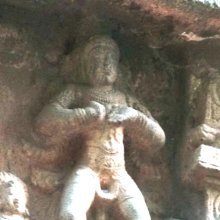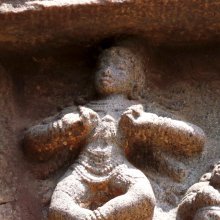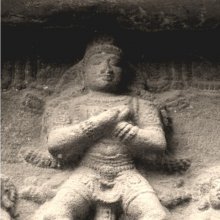Uromandala, Uras-mandala, Uromaṇḍala: 2 definitions
Introduction:
Uromandala means something in Hinduism, Sanskrit. If you want to know the exact meaning, history, etymology or English translation of this term then check out the descriptions on this page. Add your comment or reference to a book if you want to contribute to this summary article.
Images (photo gallery)
In Hinduism
Natyashastra (theatrics and dramaturgy)
Source: Wisdom Library: Nāṭya-śāstraUromaṇḍala (उरोमण्डल).—One of the 108 karaṇas (minor dance movement) mentioned in the Nāṭyaśāstra chapter 4. The instructions for this uromaṇḍala-karaṇa is as follows, “two feet drawn away from the Svastika position and used in Apaviddha (Aḍḍitā) Cārī and hands in Uromaṇḍala gesture.”.
A karaṇa represents a minor dance movements and combines sthāna (standing position), cārī (foot and leg movement) and nṛttahasta (hands in dancing position).
Source: Shodhganga: Elements of Art and Architecture in the Trtiyakhanda of the Visnudharmottarapurana (natya)1) Uromaṇḍala (उरोमण्डल) or Uromaṇḍalaka refers to one of the thirty Nṛttahastas or “dance hand gestures” (in Indian Dramas), according to the Viṣṇudharmottarapurāṇa, an ancient Sanskrit text which (being encyclopedic in nature) deals with a variety of cultural topics such as arts, architecture, music, grammar and astronomy.—The hasta-mudrās (lit. “hand-gestures”) are very essential to denote some particular action or state in dancing and these mudrās are formed with the help of hands and fingers. In the Viṣṇudharmottarapurāṇa, thirty kinds of nṛttahastas (“dance-hand gestures”) are mentioned. e.g., uromaṇḍalaka. The practice of these nṛttahastas is strictly prohibited in sickness of body, in old age, in fear, drunk and anxiety.
2) Uromaṇḍala (उरोमण्डल) refers to one of the 108 kinds of Karaṇa (“coordination of precise movements of legs and hands”), according to the Viṣṇudharmottarapurāṇa.—Accordingly, karaṇas are the coordination of precise movements of legs and hands performed in a particular posture. The Nāṭyaśāstra also gives its view point in the same spirit. In the Viṣṇudharmottarapurāṇa, one hundred and eight kinds of karaṇas are accepted, e.g., Uromaṇḍala.

Natyashastra (नाट्यशास्त्र, nāṭyaśāstra) refers to both the ancient Indian tradition (shastra) of performing arts, (natya—theatrics, drama, dance, music), as well as the name of a Sanskrit work dealing with these subjects. It also teaches the rules for composing Dramatic plays (nataka), construction and performance of Theater, and Poetic works (kavya).
See also (Relevant definitions)
Partial matches: Uro, Uras, Mandala.
Starts with: Uromandalahasta, Uromandalaka, Uromandalakahasta.
Full-text: Uromandalin, Akshiptaka, Vishkambhapasrita, Parshvaccheda, Paryastaka, Gatimandala, Mattakrida, Uromandalahasta, Aparajita, Ardhanikuttaka, Alidha, Vaishakharecita, Akshiptarecita, Sambhranta, Sucividdha, Udghattita, Recita.
Relevant text
Search found 2 books and stories containing Uromandala, Uras-mandala, Uromaṇḍala, Uro-mandala, Uro-maṇḍala, Urasmandala, Uras-maṇḍala; (plurals include: Uromandalas, mandalas, Uromaṇḍalas, maṇḍalas, Urasmandalas). You can also click to the full overview containing English textual excerpts. Below are direct links for the most relevant articles:
Vishnudharmottara Purana (Art and Architecture) (by Bhagyashree Sarma)
2.5. Karaṇa (movements of legs and hands) < [Chapter 3 - Drama and Dance]
Natyashastra (English) (by Bharata-muni)


